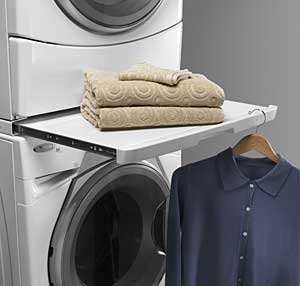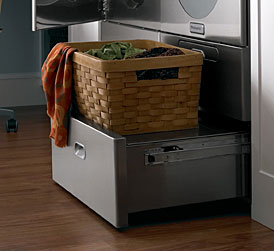Universal Design Solutions: Integrating Innovative Products and Spatial Design
Interest in universal design will grow in the future. Look first at the statistics: In 2004, 63 million Americans were 55 years or older. Between now and 2012, another 3.4 million will reach that age bracket each year. These consumers are already expressing an interest in "aging in place." The National Kitchen and Bath Association reports that 30 percent of consumers are considering universal design elements for their home. And log onto the Internet and you'll find an array of organizations promoting the housing, and health, benefits of aging in place. There are universal design demonstration homes. The National Association of Home Buildings teaches the technical, management, and customer service skills required in universal design applications.
 |
A new slide-out shelf allows ease-of-use for unloading the top-mounted dryer. |
As mentioned in this article universal design is not a science. It requires only an awareness of need and market and a common sense approach to making everything that is designed and produced usable by everyone to the greatest extent possible. As such, there are no "rules" per se, for universal design, just principles and tips that can guide you in your pursuit. Therefore, the following are meant as just that: guidelines for exploration, discussions, and revision.
First, though, consider universal design in relationship to current kitchen design trends and you will discover that some of the new "advances" are, maybe unwittingly, incorporating universal design principles. Once a strictly utilitarian space meant for preparing meals, the kitchen is now the hub of the home, where the family gathers in the evenings to share meals, do homework, and entertain friends. There has been a shift in emphasis from the classic triangle to work zones, and the room's overall size has expanded significantly. Kitchens are seen as more unique, personal spaces, and not necessarily cookie-cutter versions. There is often the need to make the kitchen accessible and multigenerational.
And this is being accomplished in accordance with the golden rule of universal design- to find solutions that are "invisible." The solutions use color, scale, texture, line and light to create spaces that have harmony, balance and proportion.
Consider the following, the flexibility of kitchen zones designed for a variety of activities allows the incorporation of different design elements-counter tops of varying heights, the use of different sized appliances, concentrated lighting. Think of a prep area with a small sink, cutting board, and microwave oven. This zone can and may be easily accessible to someone in a wheelchair, or someone with another disability. Wall cabinets are being sacrificed for open space, which leads to more horizontal cabinets that may come with doors that lift up awning-style. And those counter tops of varying heights can double as desktops or a lower counter surface on which to knead bread.
Appliance manufacturers, too, are keen to the aging population. The manufacturers aim to meet consumers needs, making their products easier to use and more efficient. Industrial designers, in particular, see ergonomics as a more part of universal design. What is a less stressful way to pull out an oven rack? Does a warming drawer actually provide more functionality to a kitchen? How tall should a washing machine's pedestals be?
An in-depth examination of the following principles of universal design, design tips, appliance usability features, and design features in housing can lead to a greater understanding and application of these ideas.
<--PAGEBREAK 8-->
Seven Principles of Universal Design
Developed by Ronald Mace and the Center for Universal Design, North Carolina State University
1. Equitable Use: In order to achieve equitable use, the design should be useful and marketable to people with diverse abilities. The design should provide the same means of use for all individuals (identical whenever possible, equivalent when not), without segregating or stigmatizing any users. The design should also be appealing to all, with the same provisions for privacy, security, and safety equally available to everyone.
2. Flexibility in Use: To achieve flexibility in use, the design should accommodate a wide range of individual preferences and abilities. Users should be provided with choice in method of use and design should accommodate right- or left-handed access and usability (e.g. right- versus left-handed scissors). In addition, the design should facilitate the user's accuracy and precision, and provide adaptability to the user's ability and pace.
3.Simple, Intuitive Use: Designs that offer simple and intuitive use should be easy to understand, regardless of the individual's experience, knowledge, language skills, or current level of concentration. The use of the design should be consistent with the user's expectations and intuition, and information should be arranged in a manner consistent with its importance. Unnecessary complexity should be eliminated wherever possible.
4. Perceptible Information: Designs should effectively communicate the necessary information to the user, regardless of ambient conditions or the user's sensory abilities. It is important to incorporate different modes of communication (pictorial, verbal, tactile) to provide redundant presentation of essential information. The legibility of essential information should be maximized by providing adequate contrast between the information and its surroundings.
 |
| Laundry-pair pedestals with incorporated shelving units reduce bending and stooping when transferring laundry from washer to dryer and ultimately to the basket for removal from the laundry area. |
5. Tolerance for Error: To provide tolerance for error, designs should minimize the hazards and adverse consequences of accidental or unintended actions. Elements should be arranged to minimize hazards and errors. The most used elements should be the most accessible, while potentially hazardous elements should be shielded, isolated, or eliminated. Designs should provide warnings of hazards and errors, as well as fail safe features.
6. Low Physical Effort: Designs that require low physical effort must be able to be used efficiently and comfortably by all users, with a minimum of fatigue. It is important for the design to allow the individuals to maintain a neutral body position and that the design should be able to function with reasonable operating forces. The need for the user to undertake repetitive actions or exert a sustained physical effort should be minimized.
7.Size and Space for Approach and Use: Designs should provide appropriate size and space for approach, reach, manipulation, and use, regardless of the individual's body size, posture, or mobility. Both seated and standing users should be able to comfortably reach all components of the design, with a clear line of sight to any important elements. The design should accommodate variations in hand and grip size and provide adequate space for the use of assistive devices, such as wheelchairs and walkers, or personal assistance.









